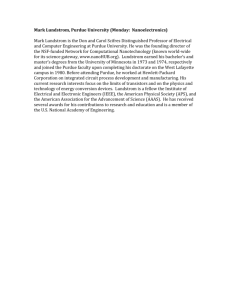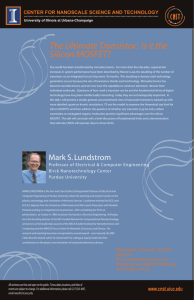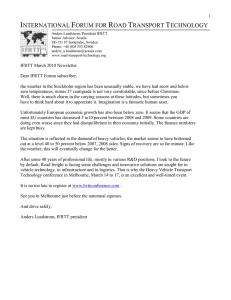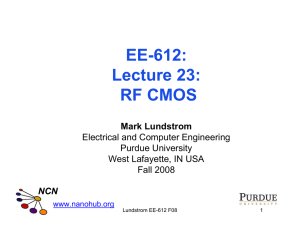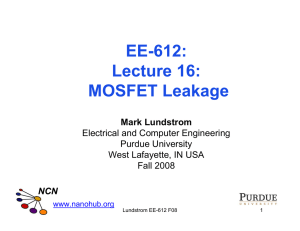EE-612: Nanoscale Transistors Fall 2006 Mark Lundstrom Electrical
advertisement
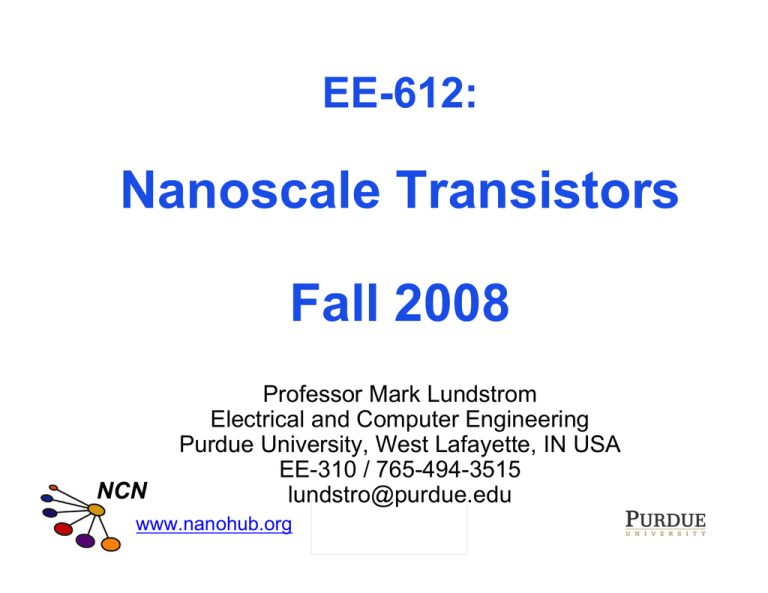
EE-612: Nanoscale Transistors Fall 2008 NCN Professor Mark Lundstrom Electrical and Computer Engineering Purdue University, West Lafayette, IN USA EE-310 / 765-494-3515 lundstro@purdue.edu www.nanohub.org Lundstrom EE-612 F08 evolution of silicon technology source drain silicon gate oxide SiO Lundstrom EE-612 F08 2 (1-2nm) SiO2 Bell Labs, 1947 channel (~ 40nm) 2 technology trends….. 5 μm ‘Moore’s Law’ 10 9 ↑ log # chip ↑ log L 50 nm 5 nm 1975 10 3 2005 Lundstrom EE-612 F08 20st Century electronics transistors per cpu chip Lundstrom EE-612 F08 course outcomes After taking this course, students should: » Understand nanoscale MOSFET device physics. » Appreciate how device performance affects circuits and systems. » Be familiar with device scaling challenges. » Be introduced to new Si-based material and device approaches as well as other transistors. » Have the confidence to go “one-on-one” with device engineers and researchers. Lundstrom EE-612 F08 5 course prerequisites » Introductory level understanding of semiconductor physics and devices as well as basic electronic circuits. (EE255 and EE305/606 at Purdue) (some basic MOS physics, devices, and CMOS circuits will be briefly reviewed) Lundstrom EE-612 F08 6 course outline Part 1: MOSFET fundamentals 6 weeks including 1 exam Part 2: Short channel MOSFETs and technology 5.5 weeks including 1 exam Part 3: Circuits, new materials and structures, and other transistors 3.5 weeks Lundstrom EE-612 F08 7 course text Fundamentals of Modern VLSI Devices Yuan Taur and Tak Ning supplemented with class notes Cambridge Univ. Press, 1998 www.cup.cam.ac.uk/ Lundstrom EE-612 F08 8 lecture format • ~60 minute (PowerPoint) lectures followed by 15 min of questions and answers. • Recorded and deployed online soon after. • Possible evening sessions from time to time on special topics, make-up lectures, HW discussions, etc. Lundstrom EE-612 F08 9 why simulations in EE-612 • As “laboratory” exercises (e.g. HW1) • To solve equations that we can’t solve by hand (e.g. quantum effects on MOS-CV, 2D electrostatics, etc.) • To illustrate concepts (Hamming’s “insight not numbers”) • To learn how to be an intelligent user of simulation tools (no ‘Spice monkeys’ – learn to “stand up to the computer”) Lundstrom EE-612 F08 10 course grading Exam 1: 25% -MOS and MOSFET fundamentals Exam 2: 25% -short channel MOSFETs, circuits and systems Homework: 25% Final: 25% Lundstrom EE-612 F08 11 some suggestions 1) Do the reading before class (and after). 2) Supplement with online lectures. 3) Monitor IEEE Trans. Electron Devices and Electron Device Letters (and ask me questions). 4) Attend relevant departmental / Discovery Park seminars. 5) Monitor the course homepage for announcements, handouts, etc. (http://cobweb.ecn.purdue.edu/~EE612). 6) Do the homework. Lundstrom EE-612 F08 12 HW 1 • Due Tuesday, Sept. 2, 2008. At the beginning of class! • You will review MOSFETs, learn how to run simulations, and characterize a state-of-the-art MOSFET. • And I’d like you to tell me about yourself and your goals for the course. • HW will be lightly graded, and solutions will be posted. Your lowest HW score will be dropped when computing the final HW average. Students who need to miss class should plan accordingly. If you plan to be sick, please factor that in. One and only one HW score will be dropped. Lundstrom EE-612 F08 13 EE-612 For additional information, refer to the course syllabus (also available on the class homepage) Feel free to contact me at lundstro@purdue.edu Good luck in EE-612! Lundstrom EE-612 F08 14
